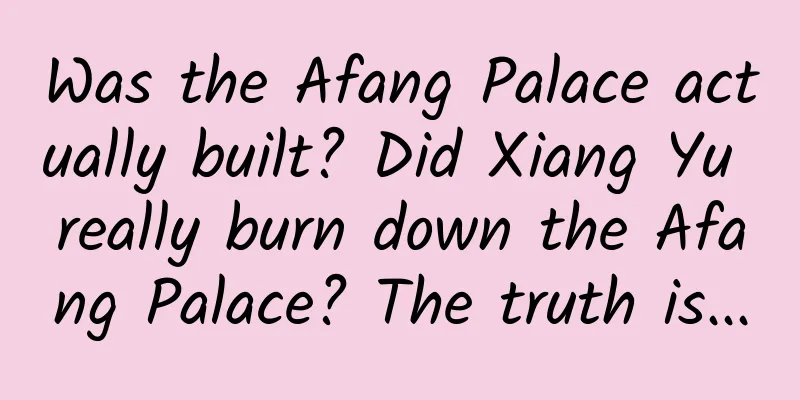Was the Afang Palace actually built? Did Xiang Yu really burn down the Afang Palace? The truth is...

|
On July 5, 2023, the Science Popularization China Starry Sky Forum, with the theme of "Empowering Cultural Relics with Science and Technology to Bring Them to Life", invited 5 cultural and historical experts from different fields to talk about how science and technology can empower cultural relics protection and make cultural heritage timeless from the aspects of cultural relics excavation, restoration, display, protection and exchange. Liu Rui, a researcher at the Han and Tang Dynasty Archaeology Research Office of the Institute of Archaeology, Chinese Academy of Social Sciences, gave a speech: "Enlightenment from the Archaeology of Afang Palace" The following is an excerpt from Liu Rui’s speech: Du Mu of the Tang Dynasty wrote in "Fu on Afang Palace": "Six kings are gone, the four seas are one. The mountains of Shu are steep, and Afang Palace emerges. It covers more than 300 miles, blocking out the sky and the sun...", describing the Afang Palace as very majestic and grand. However, Sima Qian of the Western Han Dynasty recorded the following about the Afang Palace in the Records of the Grand Historian: The First Emperor of Qin: "In the thirty-fifth year, ... the First Emperor thought that there were too many people in Xianyang and that the palaces of the previous kings were too small. I heard that King Wen of Zhou had his capital in Feng and King Wu had his capital in Hao. The area between Feng and Hao was the capital of the emperor. So he built a palace in the Shanglin Garden in Weinan. First, build the front hall, Afang, which is 500 steps from east to west and 50 zhang from north to south. It can accommodate 10,000 people on the top and 50 zhang flags on the bottom. A gallery was built around it, which went straight from the bottom of the hall to the South Mountain. The top of the South Mountain was marked as a gate. A double-story road was built, which crossed the Wei River from Afang and connected to Xianyang, to resemble the Tianji gallery that crossed the Han River and reached the camp. The Afang Palace was not yet completed; when it was completed, they wanted to choose a better name for it. They built the palace Afang, so the world called it the Afang Palace. There were more than 700,000 prisoners in the hidden palace, and they were divided up to build the Afang Palace or the Lishan Palace. The stone coffins from the northern mountains were taken, and the materials from Shu and Jing were all brought in. " This passage means that Qin Shihuang felt that there were too many people in Xianyang and the original place they lived was too small, so he wanted to follow the example of King Wen and King Wu of Zhou and rebuild the palace in Shanglin Garden in Weinan. He first built the front hall, Afang, with a scale of "500 steps from east to west and 50 meters from north to south, with enough space for 10,000 people to sit on the top and 50-meter flags to be set up on the bottom", but Afang Palace was never built. The reason why it was called "Afang Palace" was also related to the fact that the Afang Palace was not completed. Sima Qian explained that he built a palace in a place called "Afang" and wanted to give it a nice name after the palace was completed, but because the Afang Palace was not built, it did not have the opportunity to become famous. Part of "Twelve Screens of Afang Palace" by Yuan Jiang of the Qing Dynasty Which of these two different versions should we listen to? Fortunately, we have archaeology, through which we can understand the true Afang Palace. Archaeological research Restore a real Afang Palace There is a village called "Afang Palace Village" in the western suburbs of Xi'an, Shaanxi Province, and there are many rammed earth platforms related to Qin Shihuang, such as "Shihuang Shangtiantai", "Magnetic Stone Gate", "Beacon Tower", etc. There is also an "Ancient City Village", and next to the Ancient City Village there is a huge rammed earth platform. In 1906, Japanese Kiroku Adachi worked as a foreign teacher at Northwest University and conducted a series of investigations in the vicinity of Xi'an. In his book "A Study of Historical Sites of Chang'an", he called the place on the south side of the Afang Palace Village mentioned above, locally called "The First Emperor's Ascending Terrace", "Afang Palace". Later, many maps marked "Qi Huang Ascending the Tiantai" as "Afang Palace" based on this. "The First Emperor ascends the Tiantai Terrace". Photo courtesy: Liu Rui In the spring of 1933, the then National Peking Academy of History Institute, led by Mr. Xu Xusheng , began archaeological work in Shaanxi Province with the goal of exploring the "early culture of the Zhou and Qin peoples". During the spring survey, due to the short time, the previous opinion that "Shangtiantai" was the Afang Palace was continued. But after a second investigation in the autumn, they changed their opinion and pointed out that the huge platform located in the southeast of Gucheng Village was the "Afang Palace" . This opinion was quickly recognized by scholars in Xi'an at that time. In the left picture, you can see that there are two "Afang Palaces". The one in the square is the Afang Palace next to Gucheng Village, which is what Mr. Xu Xusheng believes to be the "Afang Palace". The Afang Palace in the circle is the original "Qiuhuang Shangtiantai". Photo courtesy: Liu Rui In the spring of 1951, Su Bingqi, Shi Xingbang and other scholars from the Institute of Archaeology of the Chinese Academy of Sciences conducted the first archaeological survey in Shaanxi after the founding of the People's Republic of China. According to the data published in 1956, Su Bingqi continued the opinions of the previous survey in the autumn of 1933 and believed that the platform in the southeast of Gucheng Village was the "Afang Palace". In May 1955, Mr. Xia Nai of the Institute of Archaeology conducted a special investigation on the ruins of the Afang Palace while on a business trip to Xi'an . He believed that the area of the Shangtian Terrace, where the survey site named "Afang Palace" was located, was too small. "The large platform to the west is nearly a kilometer long from east to west and five or six meters thick (each layer is about 5.5 to 8 centimeters)", which is the Afang Palace. Rammed earth foundation of the Afang Palace. Photo courtesy: Liu Rui In 1956, the Shaanxi Provincial People's Committee promulgated the "List of the First Batch of Cultural Relics and Historical Sites Protected in Shaanxi Province", among which the Afang Palace Ruins were listed , and the protection scope was announced in the form of Afang Palace Ruins (I) and Afang Palace Ruins (II). Among them, "Afang Palace Site (I)" is the traditional "Afang Palace", which is a series of rammed earth platforms centered on the "Shangtian Terrace". "Afang Palace Site (II)" is the "Afang Palace" proposed by archaeologists, which is the rammed earth platform in the southeast of Gucheng Village. The ruins of Afang Palace on the map. Photo courtesy: Liu Rui In 1961, when the State Council announced the first batch of national key cultural relics protection units, the "Afang Palace Ruins" was no longer divided into (one) and (two). However, from the perspective of management procedures, the scope of this "Afang Palace" should be consistent with the provincial protection scope announced by Shaanxi Province. Although the list of cultural relics protection units does not deny the customary understanding represented by "Shangtiantai" and centered on the Afang Palace Village, the location of the Afang Palace investigated and identified by Mr. Xu Xusheng, Su Bingqi, Xia Nai and others was confirmed in the form of government decrees. Precious pictures of early cultural relics protection signs. Photo courtesy: Liu Rui However, the above information about the location of "Afang Palace" has not been explored by the Luoyang shovel, nor has it been excavated by archaeology. In the winter of 1994, the Xi'an Cultural Relics Bureau organized an archaeological team to conduct a large-scale cultural relic drilling and investigation within the 10 square kilometers of the Afang Palace Site Protection Area . They discovered 18 rammed earth sites and achieved a series of important results, providing scientific data for the study of the basic structure of the Afang Palace. Photo courtesy: Liu Rui From 2002 to 2004, the Afang Palace archaeological team composed of the Institute of Archaeology of the Chinese Academy of Social Sciences and the Xi'an Institute of Cultural Relics Protection and Archaeology conducted a comprehensive drilling of the ruins of the front hall of the Qin Afang Palace . "We have basically figured out the scope of the front hall of the Afang Palace and the distribution of its relics," confirmed that "the rammed earth platform of the front hall site is the rammed earth platform of the front hall site of the Qin Afang Palace," and determined that " the front hall site of the Afang Palace was not burned by fire." The left picture shows the use of Luoyang shovel for shoveling. Photo courtesy: Liu Rui After carrying out the above series of archaeological work, it was not only determined that only the "front hall" of the Afang Palace was built, but also that the "front hall" was not built, and only the rammed earth base and its north, east and west walls were built . Moreover, "the scope of the unfinished Afang Palace is consistent with the current understanding of the front hall of the Afang Palace." The "front hall" is the Afang Palace, which is not only consistent with the records in "Records of the Grand Historian" and "Book of Han", but also consistent with the judgment of Mr. Xu Xusheng, Su Bingqi and Xia Nai on the ruins of the Afang Palace. Photo courtesy: Liu Rui But we need to know why Du Mu wrote "Fu on Afang Palace". In another article, "A Letter to My Friend," he said: "During the Baoli period, the palaces were built on a large scale and music and dance were indulged, so I wrote the "Ode to the Afang Palace." "Baoli" refers to Emperor Jingzong of Tang, who renovated palaces and indulged in sensual pleasures. To Du Mu, it didn't matter how well the palaces were built, as he did not verify this. He simply used the reputation of the Afang Palace and the death of Qin II to say that an emperor should not do this. Enlightenment from the Archaeological Excavation of Afang Palace Although the scenes of the Afang Palace revealed by archaeologists are cruel in the eyes of many people, this is precisely the value of science. The truth about the Afang Palace that archaeologists continue to reveal not only breaks the imagination of the Afang Palace constructed from the "Afang Palace Fu", but also proves that Sima Qian's "Afang Palace was not completed" is correct. Only by believing in science can we increasingly understand the real world and history. |
Recommend
If you don't do these three things, your refrigerator will contain at least four more pathogens! The correct approach is...
A cold and airtight refrigerator is the best plac...
When is the cheapest time to buy a mobile phone? Here are the insider's tips
This question is indeed worth pondering. Many peo...
What time is it today? What month and day is Jingzhe? Here are some beautiful sentences to welcome the spring during the Jingzhe solar term!
What time is Jingzhe today? What month and day is...
40th Anniversary Walkman: NW-ZX505 Hands-On Review
For all music enthusiasts, Sony's Walkman ser...
4 big mistakes that Jack Ma has made over the years
Recently, Jack Ma brought 1.2 billion yuan to Ever...
There are more and more varieties of milk on the market. Which one is more worth buying?
Milk not only supplements calcium, but is also ve...
A major breakthrough in 50 years! A "huge field" was discovered in Henan, with crude oil resources exceeding 100 million tons!
Recently, important news came from the 2024 Natio...
Make money by scanning QR code on Alipay every day, the maximum amount of red envelopes you can get with Alipay is 99 yuan, and you can receive it every day!
Welfare is coming! You can make money by scanning...
Chongqing has trained its first batch of drug-sniffing squirrels! I am a civil servant!
Recently, the drug-hunting squirrel has become a ...
There is a kind of romance in the universe, I am your companion star
Alien planetary system has a Jupiter world 99 tim...
Principal Lao Li's Live Room 2022
Principal Lao Li's live broadcast room 2022 r...
What are the key points to pay attention to when choosing server hosting?
The hosting server can be as small as possible Ev...
Promotion Classroom | Baidu Information Flow Advertising Optimization Tips Sharing
1. What is information flow advertising ? TA is a...
After Ji Yue falls, who will be the next?
Cars come and go, people come and go. In the tide...
4000 words of essence | Teach you how to bid and adjust prices for cpc+ocpc accounts
There are two ways to bid on big searches now. Ol...









